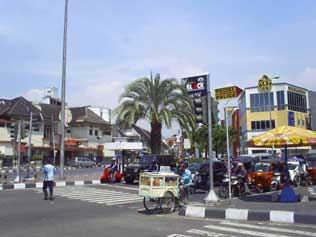Cikini – An Historical Area: Jakarta, West Java
 Two centuries ago, Cikini stood on the sidelines while neighbouring areas were developed into new settlements for the wealthy. Now it is catching up by doing what it knows best: making way for business. Entering Cikini from the north, one can almost see how the small district in Central Jakarta has developed into a commercial center that supports neighbouring residential areas Menteng and Gondangdia.
Two centuries ago, Cikini stood on the sidelines while neighbouring areas were developed into new settlements for the wealthy. Now it is catching up by doing what it knows best: making way for business. Entering Cikini from the north, one can almost see how the small district in Central Jakarta has developed into a commercial center that supports neighbouring residential areas Menteng and Gondangdia.
Two buildings stand facing each other. One is a box-like building from the modern era, the other is a row of art deco shop-houses from the early 1900s. Despite the contrast, both are filled with a wide array of businesses, from small photocopy shops to trendy cafes.
Cikini has been a commercial and service area since the Dutch colonial era.
When the Dutch opened up a new settlement, Weltevreden, in the late 18th century — after it was decided Old Batavia was too unhealthy to live in any longer, Cikini was left out.
The Dutch developed Koningsplein (now Medan Merdeka) as a residential area for officials, Waterlooplein (now Lapangan Banteng) as a military and government center, and later on Menteng as a new residential area, using the concept of a garden city.
Cikini was just a plot of land standing on the side of weg naar Menteng, or the road leading to Menteng, where landlords built houses on their own.
But being unplanned was Cikini’s original plan.
“In 1864, renowned painter Raden Saleh donated a 10-hectare plot of land to the Society for Plants and Animals to be developed as an amusement park and a zoo,” Adolf Heuken wrote in Historical Sites of Jakarta.
As the previously private land was opened up to the public, more people began visiting Cikini.
That was the beginning of the area’s role as a business and service area, particularly for the as-yet-developed Menteng.
Soon after the development of Menteng in the 1920s, houses along Cikini started to make way for businesses. A photograph taken in 1927 shows businesses opened up along the main road in the area, including laundries and drugstores.
Later, Raden Saleh’s house was turned into a ziekenhuis, or house for the sick, later becoming PGI Cikini hospital.
Raden Saleh was probably the man most responsible for the further development of Cikini, as he donated another plot of land that was developed into state elementary school SMP 1.
As more people came into the area, the more Cikini developed itself as a business and service center.
And Cikini maintains that role today. The old zoo was relocated to Ragunan, in South Jakarta, making way for another public center, Taman Ismail Marzuki, in 1966.
For those old enough to remember, Cikini will also remind them of an attempt on the life of Indonesia’s first president, Sukarno, on Nov. 30, 1957.
Sukarno was attending a charity event at his children’s school, Perguruan Cikini, when an assailant threw two hand grenades into the school complex. He survived the attack.
In the 1960s, several restaurants opened in the area, some still surviving to this day.
Despite its unplanned image as a commercial area, the little alleys running off Jl. Cikini Raya still hide several old houses, as well as some newer one, that form a kampong behind the business area. But many of these houses are making way for more businesses.
A handful of multistorey hotels welcome guests. Hotel Formule 1, a new arrival to the area, has already purchased a lot for a second hotel.
Office buildings sprout up here and there, with cafes snuggled in between.
Planned or unplanned, Cikini has never denied its fate.
Anissa S. Febrina